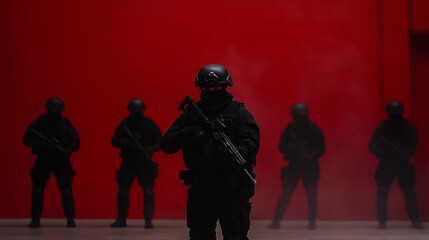How to Survive Localized Terrorist Attacks

Podcast: Play in new window | Download
Localized terrorist attacks are a terrifying but real possibility in today’s world. They may not make global headlines, but their impact on the lives of those affected can be profound. These events often target public areas where everyday people gather—places you might go without a second thought. Preparing for such a scenario is not about living in fear but rather equipping yourself with the knowledge to survive if the unthinkable happens.
In this episode, we’ll explore practical steps to help you stay safe, remain calm, and take action if you ever find yourself in an attack.
Quick Look at What You’ll Learn
Understanding Localized Terrorist Attacks
Terrorist attacks vary greatly in scale and intensity. While large-scale attacks get the most attention, smaller, localized events are more common and just as dangerous. Localized terrorist attacks can happen anywhere—shopping malls, schools, transportation hubs, or even places of worship. These are often called “soft targets,” meaning they lack the security measures found in government buildings or airports.
Knowing the types of attacks that can happen is the first step to being prepared. These include:
- Bombings: Explosive devices can be hidden in public areas, making them hard to detect.
- Active Shooter Situations: A gunman may target crowded places, intending to harm as many people as possible.
- Vehicular Attacks: Vehicles are increasingly used to mow down crowds in public spaces.
Understanding these possibilities can help you be more aware of your surroundings and recognize warning signs that something isn’t right.
Where Could Localized Terrorist Attacks Occur?
While predicting every location that could be attacked is impossible, certain places are more vulnerable than others. Terrorists often look for places where they can cause the most disruption and harm.
Public Spaces and Events
Large public gatherings like concerts, sporting events, and festivals are prime targets. These venues often attract large crowds with minimal security compared to more fortified locations. Before attending such events, take a moment to survey the layout. Make a mental note of the exits and security presence. Be mindful of anything unusual, like unattended bags or suspicious behavior.
Public Transportation
Airports, train stations, and bus terminals are often crowded and can be easy targets due to the number of people moving in and out. When in these environments, avoid lingering in high-traffic areas and stay close to exits. If possible, familiarize yourself with the security protocols to act quickly if something goes wrong.
Places of Worship
Unfortunately, even places of peace like churches, mosques, and synagogues can be vulnerable to attacks. These are often considered symbolic targets, and the regularity of worship schedules makes them predictable. Religious communities should consider increasing security or discussing emergency plans with their congregations.
Shopping Malls and Markets
Shopping malls and public markets are soft targets where crowds gather with little oversight. In these environments, always be mindful of where the exits are, and if anything seems suspicious, don’t hesitate to leave or alert security personnel.
What You Can Do to Stay Safe
Now that we’ve covered where attacks might occur let’s focus on what you can do to stay safe. While you can’t predict when or where an attack will happen, there are practical steps you can take to improve your chances of survival.
Situational Awareness
Situational awareness is key in any dangerous scenario. Wherever you are, always take a moment to assess your surroundings. Note the exits and pay attention to the people around you. If something feels off—trust your instincts. We often ignore gut feelings, but they can be crucial in helping us avoid dangerous situations.
Here’s a simple trick: Imagine an emergency and mentally map out your exit strategy whenever you enter a new environment. Are there obstacles? Is there a clear path to safety? This small mental exercise can make a big difference.
Have an Emergency Plan
It’s essential to have a personal emergency plan in place, especially if you’re with family or loved ones. Know where to meet if you’re separated and how you’ll communicate if cell networks go down. Sometimes, something as simple as having a designated meeting point outside of a crowded venue can save time and reduce panic.
Consider putting together a small “go-bag” with essentials like a first aid kit, emergency cash, phone chargers, and identification. Having these on hand can be a lifeline if you need to leave quickly.
How to Survive During an Attack
When an attack occurs, every second counts. The Department of Homeland Security recommends the Run, Hide, Fight strategy in active shooter situations, and it can be adapted to most localized terrorist attacks.
- Run: If you can safely escape, do so immediately. Don’t wait to see what happens or gather your belongings—your priority is to get out fast.
- Hide: If running isn’t an option, find a secure hiding place. Look for something that offers cover from gunfire or explosions, not just concealment.
- Fight: As a last resort, if you’re directly threatened, you may need to fight. This is the riskiest option, but it’s better than becoming a passive target. Use any objects around you as weapons—fire extinguishers, chairs, or even your bag.
It’s also important to stay low and move fast. In chaotic situations, confusion can be your ally. Make yourself a hard target by avoiding open spaces and using buildings or other obstacles as cover.

What to Do After the Attack
The immediate aftermath of a terrorist attack can be chaotic and disorienting. If you’re safe, focus on helping others without putting yourself in danger. Stay calm and assist first responders by providing any useful information about the attackers or the situation. If you’re trained in first aid, you may be able to provide critical assistance to those injured while waiting for medical help to arrive.
Dealing with Trauma
It’s normal to feel shaken or even traumatized after experiencing or witnessing an attack. In the days and weeks following the event, you may experience heightened anxiety, trouble sleeping, or even survivor’s guilt. It’s essential to seek emotional support, whether through friends, family, or professional counselors.
The Bottom Line on How to Survive Localized Terrorist Attacks
Being prepared for a localized terrorist attack doesn’t mean living in fear. It means taking small, practical steps to protect yourself and your loved ones should the worst happen. The more informed and aware you are, the better your chances of staying safe.
Remember, surviving an attack is about quick thinking and preparation. By knowing what to do before, during, and after, you can keep yourself and those around you safer in unpredictable situations. Stay alert, be prepared, and take action if needed.
Stay safe,

Read the full article here









